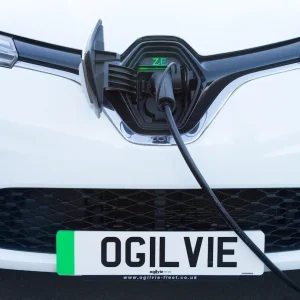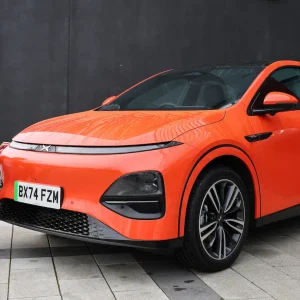Peugeot E-3008
The last 3008 was a Peugeot best-seller, with more than 1,320,000 finding customers in 130 countries for over seven years. A highlight of the last 3008 was its styling, which showed a new design direction for Peugeot at the time. The E-3008 looks more evolution than revolution. At the front, there are ultra-compact LED headlamps, with the same black strip with ‘E-3008’ in a new font, as the rear. Below this, there are the cat’s claw vertical driving lights, fitted flush next to a large grille.
At the side, with the change to ‘fastback’ styling, Peugeot have moved the roof curve to aid interior practicality. There is a tall look to the rear, with the boot lid itself having two distinctive spoilers.
Inside, the E-3008 is equally stylish, and features the latest version of Peugeot’s controversial i-Cockpit, including a floating, curved 21in panoramic screen which combines the head-up display with the central touchscreen.
The tallest will be able to get comfortable in the front of this Peugeot, thanks to plenty of seat and steering wheel adjustment. Sadly, the same cannot be said for the rear, as the curvy roof and sunroof fitted to our test car eat a lot into the headroom. The 526-litre boot is a similar size to the outgoing model and can be extended by folding the rear seats.
This Peugeot gets Stellantis’ new STLA (Stella) medium electric platform, which is scalable and can support mild hybrid, plug-in hybrid, and full EV drivetrains. With the 400V lithium-ion battery living under the floor, in E-3008 versions. The single-battery BEV version we’re covering here, and Mild Hybrid versions of the new E-3008 hit the UK in July, with the 320hp Dual Motor EV, 230hp Long Range EV, and the plug-in hybrid versions following at the end of the year.
The E-3008 shares its 2% BIK figure with the rest of this set that are also EV powered.
We’d say any EV that’s capable of more than 250 miles range is at the top of its game, but in this set, the Peugeot’s 326-mile range isn’t quite good enough for top honours. Instead that goes to the other French EV here, the Renault Scenic.
At £49,595, this Peugeot has the highest P11D figure of this group, but it is in the range-topping GT equipment grade, with the Renault only a bit behind! The Tesla is the second-cheapest and the Volvo is the cheapest. Despite being worth 46% of its original price after three years, this is only good enough for last place, with the Renault and Tesla jointly taking the crown here.
Sadly, despite coming close in this group in many areas, it just isn’t enough to push the E-3008 into top cost per mile position. In fact, it comes last with its 53.54p figure.
Peugeot E-3008 GT 73kWh
P11D: £49,595
CO2 (tax): 0g/km (2%)
BIK 20/40% a month: £16/£33
Range: 326 miles
National Insurance: £137
First year VED: £0
Subsequent VED: £0
Battery size/power: 69kWh/272hp
AFR: 9p
Residual value: 46%
Depreciation: £26,345
Fuel costs: £3,675
SMR: £2,109
Cost per mile: 53.54p
![]()
Renault Scenic
The Scenic nameplate is back on a Renault, but this time it is being sold as a crossover. Yet despite this, the French manufacturer is selling the Scenic on the roominess and practicality of its interior. One interior highlight is the SolarBay roof, fitted here, which can be changed from clear to opaque at the touch of a button, or by voice command. Read our full review on P36.
This Scenic is in range-topping Iconic spec, with the second highest P11D figure in this group (£45,440), and unsurprisingly, it has affected its standing – but it remains similar to the other models here in terms of price.
More impressive, considering the other models in this set, is the fact that at £23,000 and 51%, it has the highest residuals. On top of this, the Scenic is the lowest depreciator at £21,740. Where the Renault falls down, is that it has the second-highest SMR figure of the four cars we’re reviewing at £2,980. Despite the high residuals and low depreciation, the Scenic can only achieve the second lowest cost per mile figure here.
Renault Scenic E-Tech 87kWh Iconic
P11D: £45,440
CO2 (tax): 0g/km (2%)
BIK 20/40% a month: £15/£30
Range: 369 miles
National Insurance: £125
First year VED: £0
Subsequent VED: £0
Battery size/power: 87kWh/215hp
AFR: 9p
Residual value: 51%
Depreciation: £21,740
Fuel costs: £3,767
SMR: £2,980
Cost per mile: 47.64p

Tesla Model Y
Like the idea of the Tesla Model 3, but want more interior practicality and boot space? Well, the Model Y could be just the EV you need. The Model Y was launched back in 2021, boasting a 50mm longer body, and a taller, curvier roof which adds 150mm.
Despite being five seats only, the Model Y feels spacious inside, which is helped by the glass roof and low window line. There is also a practical 854-litre boot, which can be extended to 2,100 litres with the rear seat folded.
The RWD version that we’re focussing on is the entry-level Model Y – if you can call a car costing over £40,000 entry-level, even with the much-publicised Tesla price reductions. The Model Y is easily the fastest here, but has the smallest range (283 miles), yet owners will benefit from their impressive Supercharger network boasting over 6,000 across Europe.
Interestingly, the Model Y matches the Renault Scenic’s 51% residual value figure – the best here. Part of the reason for its mid-place finish, is because it has got the highest SMR figure, at £3,091.
Tesla Model Y RWD
P11D: £44,935
CO2 (tax): 0g/km (2%)
BIK 20/40% a month: £14/£28
Range: 283 miles
National Insurance: £124
First year VED: £0
Subsequent VED: £0
Battery size/power: 60kWh/347hp
AFR: 9p
Residual value: 51%
Depreciation: £21,750
Fuel costs: £3,479
SMR: £3,091
Cost per mile: 47.20p

Volvo EX30
Volvo’s new baby EV SUV is hugely important, and we’re pleased to say the EX30 is, in the most part, a great addition to the range. It shares its SEA (Sustainable Experience Architecture) platform, developed by Geely Holdings, with the Smart #1. Outside, the EX30 almost looks like a scaled-down mixture of the incoming EX90 and current XC40. The design instantly shouts Volvo, is attractive, sleek, has sharp detailing and looks at home on the larger 20in alloy wheels fitted as standard.
The EX30’s interior design is equally impressive, but it’s a bit of a mixed bag ergonomically. Why? Well, Volvo has removed most of the interior’s physical buttons and put them in the 12.3in central tablet screen. Space is good in the front – the seats are supportive, but rear space is tight for tall adults and the boot is a bit on the small side at 318 litres.
The 69kWh Extended Range is expected to be the most popular fleet choice, offering a competitive 295-mile range, and when it comes to charging, all EX30s can take AC and DC, with the Extended Range capable of charging from 10-80% at 153kW in just 28 minutes.
The EX30 scores top positions for SMR (£1,834), National Insurance (£116), depreciation (£21,365), and the lowest P11D value (£41,190). No surprise then, that its 45.07p cost per mile figure is the lowest here and it takes the win.
Volvo EX30 Extended Range Ultra 69kWh
P11D: £41,190
CO2 (tax): 0g/km (2%)
BIK 20/40% a month: £14/£28
Range: 295 miles
National Insurance: £116
First year VED: £0
Subsequent VED: £0
Battery size/power: 69kWh/272hp
AFR: 9p
Residual value: 48%
Depreciation: £21,365
Fuel costs: £3,845
SMR: £1,834
Cost per mile: 45.07p





